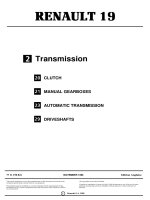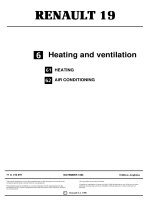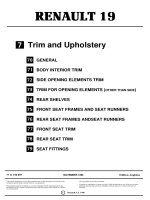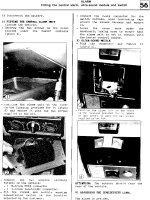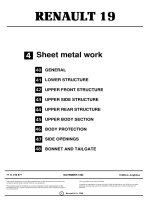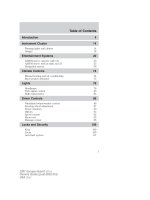Shop manual ô tô NISSAN 2000 Xterra - P17
Bạn đang xem bản rút gọn của tài liệu. Xem và tải ngay bản đầy đủ của tài liệu tại đây (3.93 MB, 82 trang )
HEATER &
AIR CONDITIONER
SECTION
HA
CONTENTS
PRECAUTIONS ...............................................................2
Supplemental Restraint System (SRS) ″AIR
BAG″ and ″SEAT BELT PRE-TENSIONER″...............2
Precautions for Working with HFC-134a (R-134a) .....3
Contaminated Refrigerant............................................3
General Refrigerant Precautions.................................3
Precautions for Refrigerant Connection......................4
Precautions for Servicing Compressor........................6
Precautions for Service Equipment.............................7
Wiring Diagrams and Trouble Diagnosis.....................9
PREPARATION .............................................................10
Special Service Tools ................................................10
HFC-134a (R-134a) Service Tools and
Equipment..................................................................11
Commercial Service Tool...........................................13
DESCRIPTION...............................................................14
Refrigeration System.................................................14
Control Operation ......................................................15
Discharge Air Flow.....................................................16
Component Layout ....................................................17
TROUBLE DIAGNOSES................................................19
Component Location..................................................19
Circuit Diagram - Air Conditioner- .............................22
Wiring Diagram - A/C - ..............................................23
How to Perform Trouble Diagnoses for Quick
and Accurate Repair..................................................26
Symptom Table..........................................................26
Operational Check.....................................................27
Blower Motor..............................................................29
Mode Door.................................................................36
Intake Door Motor......................................................38
Magnet Clutch............................................................39
Insufficient Cooling ....................................................50
Insufficient Heating ....................................................58
Noise..........................................................................60
SERVICE PROCEDURE................................................61
HFC-134a (R-134a) Service Procedure....................61
Maintenance of Lubricant Quantity in
Compressor ...............................................................63
Compressor ...............................................................67
Magnet Clutch............................................................69
Thermal Protector......................................................73
Refrigerant Lines .......................................................74
Belt.............................................................................78
Fast Idle Control Device (FICD)................................79
Heater Core...............................................................79
Evaporator Core ........................................................80
SERVICE DATA AND SPECIFICATIONS (SDS).........81
Manual.......................................................................81
GI
MA
EM
LC
EC
FE
CL
MT
AT
TF
PD
AX
SU
BR
ST
RS
BT
SC
EL
IDX
Supplemental Restraint System (SRS) “AIR
BAG” and “SEAT BELT PRE-TENSIONER”
NGHA0060
The supplemental Restraint System such as “AIR BAG” and “SEAT BELT PRE-TENSIONER” used along with
a seat belt, helps to reduce the risk or severity of injury to the driver and front passenger for certain types of
collision. The Supplemental Restraint System consists of driver air bag module (located in the center of the
steering wheel), front passenger air bag module (located on the instrument panel on passenger side), seat
belt pre-tensioners, a diagnosis sensor unit, a crash zone sensor (4WD models), warning lamp, wiring har-
ness and spiral cable.
Information necessary to service the system safely is included in the RS section of this Service Manual.
WARNING:
¼ To avoid rendering the SRS inoperative, which could increase the risk of personal injury or death
in the event of a collision which would result in air bag inflation, all maintenance must be performed
by an authorized NISSAN dealer.
¼ Improper maintenance, including incorrect removal and installation of the SRS, can lead to per-
sonal injury caused by unintentional activation of the system. For removal of Spiral Cable and Air
Bag Module, refer to RS-16.
¼ Do not use electrical test equipment on any circuit related to the SRS unless instructed to in this
Service Manual. Spiral cable and wiring harnesses (except “SEAT BELT PRE-TENSIONER”) cov-
ered with yellow insulation either just before the harness connectors or for the complete harness
are related to the SRS.
PRECAUTIONS
Supplemental Restraint System (SRS) “AIR BAG” and “SEAT BELT PRE-TENSIONER”
HA-2
Precautions for Working with HFC-134a
(R-134a)
=NGHA0061
WARNING:
¼ CFC-12 (R-12) refrigerant and HFC-134a (R-134a) refrigerant are not compatible. If the refrigerants
are mixed, compressor failure is likely to occur, refer to “Contaminated Refrigerant”. To determine
the purity of HFC-134a (R-134a) in the vehicle and recovery tank, use Refrigerant Recovery/
Recycling Recharging equipment (ACR4) (J-39500–NI) and Refrigerant Identifier.
¼ Use only specified lubricant for the HFC-134a (R-134a) A/C system and HFC-134a (R-134a) compo-
nents. If lubricant other than that specified is used, compressor failure is likely to occur.
¼ The specified HFC-134a (R-134a) lubricant rapidly absorbs moisture from the atmosphere. The fol-
lowing handling precautions must be observed:
a) When removing refrigerant components from a vehicle, immediately cap (seal) the component to
minimize the entry of moisture from the atmosphere.
b) When installing refrigerant components to a vehicle, do not remove the caps (unseal) until just
before connecting the components. Connect all refrigerant loop components as quickly as pos-
sible to minimize the entry of moisture into system.
c) Only use the specified lubricant from a sealed container. Immediately reseal containers of lubri-
cant. Without proper sealing, lubricant will become moisture saturated and should not be used.
d) Avoid breathing A/C refrigerant and lubricant vapor or mist. Exposure may irritate eyes, nose
and throat. Remove R-134a from the A/C system, using certified service equipment meeting
requirements of SAE J2210 (R-134a recycling equipment), or J2209 (R-134a recovery equipment).
If accidental system discharge occurs, ventilate work area before resuming service. Additional
health and safety information may be obtained from refrigerant and lubricant manufacturers.
e) Do not allow lubricant (Nissan A/C System Oil Type S) to come in contact with styrofoam parts.
Damage may result.
Contaminated Refrigerant
NGHA0267
If a refrigerant other than pure R-134a is identified in a vehicle, your options are:
¼ Explain to the customer that environmental regulations prohibit the release of contaminated refrigerant into
the atmosphere.
¼ Explain that recovery of the contaminated refrigerant could damage your service equipment and refriger-
ant supply.
¼ Suggest the customer return the vehicle to the location of previous service where the contamination may
have occurred.
¼ If you choose to perform the repair, recover the refrigerant using only dedicated equipment and contain-
ers. Do not recover contaminated refrigerant into your existing service equipment. If your facility
does not have dedicated recovery equipment, you may contact a local refrigerant product retailer for
available service. This refrigerant must be disposed of in accordance with all federal and local regulations.
In addition, replacement of all refrigerant system components on the vehicle is recommended.
¼ If the vehicle is within the warranty period, the air conditioner warranty is void. Please contact Nissan
Customer Affairs for further assistance.
General Refrigerant Precautions
NGHA0062
WARNING:
¼ Do not release refrigerant into the air. Use approved recovery/recycling equipment to capture the
refrigerant every time an air conditioning system is discharged.
¼ Always wear eye and hand protection (goggles and gloves) when working with any refrigerant or
air conditioning system.
¼ Do not store or heat refrigerant containers above 52°C (125°F).
¼ Do not heat a refrigerant container with an open flame; if container warming is required, place the
bottom of the container in a warm pail of water.
¼ Do not intentionally drop, puncture, or incinerate refrigerant containers.
¼ Keep refrigerant away from open flames: poisonous gas will be produced if refrigerant burns.
¼ Refrigerant will displace oxygen, therefore be certain to work in well ventilated areas to prevent
suffocation.
¼ Do not pressure test or leak test HFC-134a (R-134a) service equipment and/or vehicle air condi-
tioning systems with compressed air during repair. Some mixtures of air and R-134a have been
GI
MA
EM
LC
EC
FE
CL
MT
AT
TF
PD
AX
SU
BR
ST
RS
BT
SC
EL
IDX
PRECAUTIONS
Precautions for Working with HFC-134a (R-134a)
HA-3
shown to be combustible at elevated pressures. These mixtures, if ignited, may cause injury or
property damage. Additional health and safety information may be obtained from refrigerant manu-
facturers.
Precautions for Refrigerant Connection
NGHA0063
A new type refrigerant connection has been introduced to all refrigerant lines except the following portion.
¼ Front evaporator core connections.
FEATURES OF NEW TYPE REFRIGERANT CONNECTION
NGHA0063S01
¼ The O-ring is relocated in a groove for proper installation. This eliminates the chance of the O-ring being
caught in, or damaged by, the mating part. The sealing direction of the O-ring is now set vertically in rela-
tion to the contacting surface of the mating part to improve sealing characteristics.
¼ The reaction force of the O-ring will not occur in the direction that causes the joint to pull out, thereby
facilitating piping connections.
AHA534A
PRECAUTIONS
Precautions for Refrigerant Connection
HA-4
O-RING AND REFRIGERANT CONNECTION
=NGHA0063S02
LHA239
CAUTION:
Refrigerant connections in some systems use different O-ring configurations. Do not confuse O-rings
since they are not interchangeable. If a wrong O-ring is installed, refrigerant will leak at, or around,
the connection.
O-Ring Part Numbers and Specifications
NGHA0063S0201
Connec-
tion type
O-ring
size
Part number D mm (in) W mm (in)
SHA814E
New
8
92471 N8210 6.8 (0.268) 1.85 (0.0728)
Former 92470 N8200 6.07 (0.23990) 1.78 (0.0701)
New
12
92472 N8210 10.9 (0.429) 2.43 (0.0957)
Former 92475 71L00 11.0 (0.433) 2.4 (0.094)
New 16 92473 N8210 13.6 (0.535) 2.43 (0.0957)
New 19 92474 N8210 16.5 (0.650) 2.43 (0.0957)
*: Always check with the Parts Department for the latest parts information.
WARNING:
Make sure all refrigerant is discharged into the recycling equipment and the pressure in the system
is less than atmospheric pressure. Then gradually loosen the discharge side hose fitting and remove
it.
CAUTION:
When replacing or cleaning refrigerant cycle components, observe the following.
¼ When the compressor is removed, store it in the same position as it is when mounted on the car.
Failure to do so will cause lubricant to enter the low pressure chamber.
¼ When connecting tubes, always use a torque wrench and a back-up wrench.
¼ After disconnecting tubes, immediately plug all openings to prevent entry of dirt and moisture.
¼ When installing an air conditioner in the vehicle, connect the pipes as the final stage of the opera-
tion. Do not remove the seal caps of pipes and other components until just before required for
connection.
¼ Allow components stored in cool areas to warm to working area temperature before removing seal
GI
MA
EM
LC
EC
FE
CL
MT
AT
TF
PD
AX
SU
BR
ST
RS
BT
SC
EL
IDX
PRECAUTIONS
Precautions for Refrigerant Connection (Cont’d)
HA-5
caps. This prevents condensation from forming inside A/C components.
¼ Thoroughly remove moisture from the refrigeration system before charging the refrigerant.
¼ Always replace used O-rings.
¼ When connecting tube, apply lubricant to circle of the O-rings shown in illustration. Be careful not
to apply lubricant to threaded portion.
Lubricant name: Nissan A/C System Lubricant Type R
Part number: KLH00-PAGR1
¼ O-ring must be closely attached to inflated portion of tube.
¼ After inserting tube into union until O-ring is no longer visible, tighten nut to specified torque.
¼ After connecting line, conduct leak test and make sure that there is no leakage. When the gas
leaking point is found, disconnect that line and replace the O-ring. Then tighten connections of seal
seat to the specified torque.
AHA514A
Precautions for Servicing Compressor
NGHA0064
¼ Plug all openings to prevent moisture and foreign matter from entering.
¼ Do not keep the compressor in the upside down position or laid on its side for more than 10 min-
utes.
¼ When replacing or repairing compressor, follow “Maintenance of Lubricant Quantity in Compres-
sor” exactly. Refer to HA-63.
¼ Keep friction surfaces between clutch and pulley clean. If the surface is contaminated, with
lubricant, wipe it off by using a clean waste cloth moistened with thinner.
¼ After compressor service operation, turn the compressor shaft by hand more than five turns in
both directions. This will equally distribute lubricant inside the compressor. After the compressor
is installed, let the engine idle and operate the compressor for one hour.
¼ After replacing the compressor magnet clutch, apply voltage to the new one and check for normal
operation.
PRECAUTIONS
Precautions for Refrigerant Connection (Cont’d)
HA-6
Precautions for Service Equipment
NGHA0065
RECOVERY/RECYCLING EQUIPMENT
NGHA0065S01
Follow the manufacturer’s instructions for machine operation and
machine maintenance. Never introduce any refrigerant other than
that specified into the machine.
ELECTRONIC LEAK DETECTOR
NGHA0065S02
Follow the manufacture’s instructions for tester operation and
tester maintenance.
AHA559A
VACUUM PUMP
NGHA0065S03
The lubricant contained inside the vacuum pump is not compatible
with the specified lubricant for HFC-134a (R-134a) A/C systems.
The vent side of the vacuum pump is exposed to atmospheric
pressure. So the vacuum pump lubricant may migrate out of the
pump into the service hose. This is possible when the pump is
switched off after evacuation (vacuuming) and hose is connected
to it.
To prevent this migration, use a manual valve situated near the
hose-to-pump connection, as follows.
¼ Usually vacuum pumps have a manual isolator valve as part
of the pump. Close this valve to isolate the service hose from
the pump.
¼ For pumps without an isolator, use a hose equipped with a
manual shut-off valve near the pump end. Close the valve to
isolate the hose from the pump.
¼ If the hose has an automatic shut off valve, disconnect the
hose from the pump: when the hose is connected, the valve is
open and lubricating oil may migrate.
Some one-way valves open when vacuum is applied and close
under a no vacuum condition. Such valves may restrict the pump’s
ability to pull a deep vacuum and are not recommended.
SHA533D
MANIFOLD GAUGE SET
NGHA0065S04
Be certain that the gauge face indicates R-134a or 134a. Make
sure the gauge set has 1/2″-16 ACME threaded connections for
service hoses. Confirm the set has been used only with refrigerant
HFC-134a (R-134a) along with specified lubricant.
AHA560A
SERVICE HOSES
NGHA0065S05
Be certain that the service hoses display the markings described
(colored hose with black stripe). All hoses must include positive
shut off devices (either manual or automatic) near the end of the
hoses opposite the manifold gauge.
GI
MA
EM
LC
EC
FE
CL
MT
AT
TF
PD
AX
SU
BR
ST
RS
BT
SC
EL
IDX
PRECAUTIONS
Precautions for Service Equipment
HA-7
RHA273D
SERVICE COUPLERS
NGHA0065S06
Never attempt to connect HFC-134a (R-134a) service couplers to
an CFC-12 (R-12) A/C system. The HFC-134a (R-134a) couplers
will not properly connect to the CFC-12 (R-12) system. However, if
an improper connection is attempted, discharging and contamina-
tion may occur.
Shut-off valve rotation A/C service valve
Clockwise Open
Counterclockwise Close
RHA274D
REFRIGERANT WEIGHT SCALE
NGHA0065S07
Verify that no refrigerant other than HFC-134a (R-134a) and speci-
fied lubricants have been used with the scale. If the scale controls
refrigerant flow electronically, the hose fitting must be 1/2″-16
ACME.
Calibrate the scale every 3 months.
To calibrate the weight scale on the ACR4 (J-39500–NI):
1. Press Shift/Reset and Enter at the same time.
2. Press 8787. “A1” will be displayed.
3. Remove all weight from the scale.
4. Press 0, then press Enter. “0.00” will be displayed and
changed to “A2”.
5. Place a known weight (dumbbell or similar weight), between 10
and 19 lbs., on the center of the weight scale.
6. Enter the known weight using 4 digits (Example 10 lbs = 10.00,
10.5 lbs = 10.50).
7. Press Enter — the display returns to the vacuum mode.
8. Press Shift/Reset and Enter at the same time.
9. Press 6 — the known weight on the scale is displayed.
10. Remove the known weight from the scale. “0.00” will be dis-
played.
11. Press Shift/Reset to return the ACR4 to the program mode.
CHARGING CYLINDER
NGHA0065S08
Using a charging cylinder is not recommended. Refrigerant may be
vented into air from cylinder’s top valve when filling the cylinder
with refrigerant. Also, the accuracy of the cylinder is generally less
than that of an electronic scale or of quality recycle/recharge equip-
ment.
AHA274
THERMOMETER AND HYGROMETER
NGHA0065S09
An etched stem-type thermometer and a hygrometer can be used
to check the air conditioning system performance. A hygrometer is
used because the air conditioning performance depends on the
humidity.
PRECAUTIONS
Precautions for Service Equipment (Cont’d)
HA-8
Wiring Diagrams and Trouble Diagnosis
NGHA0066
When you read wiring diagrams, refer to the followings:
¼ “HOW TO READ WIRING DIAGRAMS” refer to GI-10.
¼ “POWER SUPPLY ROUTING” for power distribution circuit refer to EL-9.
When you perform trouble diagnosis, refer to the followings:
¼ “HOW TO FOLLOW TEST GROUP IN TROUBLE DIAGNOSIS” refer to GI-34.
¼ “HOW TO PERFORM EFFICIENT DIAGNOSIS FOR AN ELECTRICAL INCIDENT” refer to GI-23.
GI
MA
EM
LC
EC
FE
CL
MT
AT
TF
PD
AX
SU
BR
ST
RS
BT
SC
EL
IDX
PRECAUTIONS
Wiring Diagrams and Trouble Diagnosis
HA-9
Special Service Tools
=NGHA0286
The actual shapes of Kent-Moore tools may differ from those of special service tools illustrated here.
Tool number
(Kent-Moore No.)
Tool name
Description
KV99231260
(J-38874)
Clutch disc wrench
NT204
Removing shaft nut and clutch disc
KV99232340
(J-38874)
Clutch disc puller
NT206
Removing clutch disc
KV99234330
(J-39024)
Pulley installer
NT207
Installing pulley
KV99233130
(J-39023)
Pulley puller
NT208
Removing pulley
PREPARATION
Special Service Tools
HA-10
HFC-134a (R-134a) Service Tools and
Equipment
=NGHA0068
Never mix HFC-134a (R-134a) refrigerant and/or its specified lubri-
cant with CFC-12 (R-12) refrigerant and/or its lubricant.
Separate and non-interchangeable service equipment must be
used for handling each type of refrigerant/lubricant.
Refrigerant container fittings, service hose fittings and service
equipment fittings (equipment which handles refrigerant and/or
lubricant) are different between CFC-12 (R-12) and HFC-134a
(R-134a). This is to avoid mixed use of the refrigerants/lubricant.
Adapters that convert one size fitting to another must never be
used: refrigerant/lubricant contamination will occur and compressor
failure will result.
Tool number
(Kent-Moore No.)
Tool name
Description
HFC-134a (R-134a)
refrigerant
NT196
Container color: Light blue
Container marking: HFC-134a (R-134a)
Fitting size: Thread size
¼ large container 1/2″-16 ACME
KLH00-PAGR1
( — )
Nissan A/C System
Lubricant Type R
NT197
Type: Polyalkylene glycol oil (PAG), type R
Application: HFC-134a (R-134a) vane rotary com-
pressors (Nissan only)
Lubricity: 40 m (1.4 US fl oz, 1.4 Imp fl oz)
(J-39500-NI)
Recovery/Recycling
Recharging equipment
(ACR4)
NT195
Function: Refrigerant Recovery and Recycling and
Recharging
(J-41995)
Electrical leak detector
AHA281A
Power supply:
¼ DC 12 V (Cigarette lighter)
Function: Checks for refrigerant leaks.
GI
MA
EM
LC
EC
FE
CL
MT
AT
TF
PD
AX
SU
BR
ST
RS
BT
SC
EL
IDX
PREPARATION
HFC-134a (R-134a) Service Tools and Equipment
HA-11
Tool number
(Kent-Moore No.)
Tool name
Description
(J-39183)
Manifold gauge set
(with hoses and cou-
plers)
NT199
Identification:
¼ The gauge face indicates R-134a.
Fitting size: Thread size
¼ 1/2″-16 ACME
Service hoses
¼ High side hose
(J-39501-72)
¼ Low side hose
(J-39502-72)
¼ Utility hose
(J-39476-72)
NT201
Hose color:
¼ Low hose: Blue with black stripe
¼ High hose: Red with black stripe
¼ Utility hose: Yellow with black stripe or green
with black stripe
Hose fitting to gauge:
¼ 1/2″-16 ACME
Service couplers
¼ High side coupler
(J-39500-20)
¼ Low side coupler
(J-39500-24)
NT202
Hose fitting to service hose:
¼ M14 x 1.5 fitting is optional or permanently
attached.
(J-39650)
Refrigerant weight scale
NT200
For measuring of refrigerant
Fitting size: Thread size
¼ 1/2″-16 ACME
(J-39649)
Vacuum pump
(Including the isolator
valve)
NT203
Capacity:
¼ Air displacement: 4 CFM
¼ Micron rating: 20 microns
¼ Oil capacity: 482 g (17 oz)
Fitting size: Thread size
¼ 1/2″-16 ACME
PREPARATION
HFC-134a (R-134a) Service Tools and Equipment (Cont’d)
HA-12
Commercial Service Tool
=NGHA0067
Tool name Description Note
Refrigerant Identifier
Equipment
NT765
Checking refrigerant purity and for system contami-
nation
For details of handling methods, refer to the Instruction Manual attached to the service tool.
GI
MA
EM
LC
EC
FE
CL
MT
AT
TF
PD
AX
SU
BR
ST
RS
BT
SC
EL
IDX
PREPARATION
Commercial Service Tool
HA-13
Refrigeration System
REFRIGERATION CYCLE
NGHA0069
Refrigerant Flow
NGHA0069S01
The refrigerant flows in the standard pattern. Refrigerant flows through the compressor, condenser, liquid tank,
expansion valve, evaporator, and back to the compressor. The refrigerant evaporation through the evapora-
tor coil is controlled by an externally equalized expansion valve, located inside the evaporator case.
Freeze Protection
NGHA0069S02
The compressor cycles on and off to maintain the evaporator temperature within a specified range. When the
evaporator coil temperature falls below a specified point, the thermo control amplifier interrupts the compres-
sor operation. When the evaporator coil temperature rises above the specification, the thermo control ampli-
fier allows compressor operation.
Refrigerant System Protection
NGHA0069S03
Dual pressure switch (KA24DE Models) or Triple pressure switch (VG33E Models)
NGHA0069S0301
The refrigerant system is protected against excessively high or low pressure. The protection is effected by
either a dual pressure switch or a triple pressure switch located on the liquid tank. If the pressure falls out of
specifications, the switch opens to interrupt compressor operation.
Pressure Relief Valve
NGHA0069S0302
The refrigerant system is also protected by a pressure relief valve located on the flexible high pressure hose
near the compressor. When the pressure of refrigerant in the system increases to an abnormal level [more
than 3,727 kPa (38 kg/cm
2
, 540 psi)], the release port on the pressure relief valve automatically opens and
releases refrigerant into the atmosphere.
AHA450A
DESCRIPTION
Refrigeration System
HA-14
Control Operation
NGHA0072
AHA488A
FAN CONTROL KNOB
NGHA0072S01
This knob turns the fan ON and OFF, and controls fan speed.
MODE CONTROL KNOB
NGHA0072S03
This knob controls the direction of air flow through the front discharge outlets.
TEMPERATURE CONTROL KNOB
NGHA0072S04
This knob allows adjustment of the outlet air temperature.
RECIRCULATION (REC) SWITCH
NGHA0072S02
OFF position: Outside air is drawn into the passenger compartment.
ON position: Interior air is recirculated inside the vehicle. The indicator lamp will also light.
AIR CONDITIONER SWITCH
NGHA0072S05
The air conditioner switch controls the A/C system. When the switch is depressed with the fan ON, the A/C
relay is activated by the ECM allowing compressor operation. The indicator lamp will also light.
The air conditioner cooling function operates only when the engine is running and ambient air tem-
perature is above 2°C (35°F).
GI
MA
EM
LC
EC
FE
CL
MT
AT
TF
PD
AX
SU
BR
ST
RS
BT
SC
EL
IDX
DESCRIPTION
Control Operation
HA-15
Discharge Air Flow
NGHA0073
AHA290A
DESCRIPTION
Discharge Air Flow
HA-16
Component Layout
NGHA0272
FRONT
NGHA0272S01
AHA570A
GI
MA
EM
LC
EC
FE
CL
MT
AT
TF
PD
AX
SU
BR
ST
RS
BT
SC
EL
IDX
DESCRIPTION
Component Layout
HA-17
REAR
NGHA0272S02
AHA571A
DESCRIPTION
Component Layout (Cont’d)
HA-18
Component Location
NGHA0085
ENGINE COMPARTMENT
NGHA0085S01
KA24DE Models
NGHA0085S0101
AHA452A
GI
MA
EM
LC
EC
FE
CL
MT
AT
TF
PD
AX
SU
BR
ST
RS
BT
SC
EL
IDX
TROUBLE DIAGNOSES
Component Location
HA-19
ENGINE COMPARTMENT
NGHA0085S05
VG33E Models
=NGHA0085S0102
AHA453A
TROUBLE DIAGNOSES
Component Location (Cont’d)
HA-20
PASSENGER COMPARTMENT
NGHA0085S02
AHA533A
GI
MA
EM
LC
EC
FE
CL
MT
AT
TF
PD
AX
SU
BR
ST
RS
BT
SC
EL
IDX
TROUBLE DIAGNOSES
Component Location (Cont’d)
HA-21
Circuit Diagram — Air Conditioner—
NGHA0087
AHA516A
TROUBLE DIAGNOSES
Circuit Diagram — Air Conditioner—
HA-22
Wiring Diagram — A/C —
NGHA0274
AHA448A
GI
MA
EM
LC
EC
FE
CL
MT
AT
TF
PD
AX
SU
BR
ST
RS
BT
SC
EL
IDX
TROUBLE DIAGNOSES
Wiring Diagram — A/C —
HA-23
AHA517A
TROUBLE DIAGNOSES
Wiring Diagram — A/C — (Cont’d)
HA-24
LHA288
GI
MA
EM
LC
EC
FE
CL
MT
AT
TF
PD
AX
SU
BR
ST
RS
BT
SC
EL
IDX
TROUBLE DIAGNOSES
Wiring Diagram — A/C — (Cont’d)
HA-25

